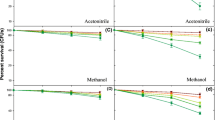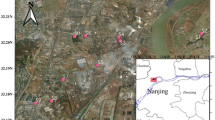Abstract
Wastewater has been widely used for agricultural irrigation in China and countries in arid and semi-arid areas. Because of poor control of the wastewater quality and long-term application, pollutants accumulation and the relevant ecotoxicological effects may occur, especially for persistent pollutants and permanently bound chemical residues. The pollutants accumulated in soil may transfer through the food chains and cause negative effects on human health. In the present study, a field survey in farmlands that have been irrigated with effluents from a sewage treatment plant and untreated wastewater was carried out. The soil quality was evaluated using a battery of chemical and biological parameters to describe the integrated situations of the polluted sites. Organochlorine pesticides (OCPs) were quantified by GC–ECD and polycyclic aromatic hydrocarbons (PAHs) were analyzed by GC-MS with internal standard. Polyphenol oxidase and catalase activities were examined to investigate the soil functions. Vicia faba micronucleus test was performed to detect the potential genotoxicity of water extracts of the soils. It has been concluded that both PAHs and OCPs have accumulated in the soils irrigated with wastewater. The main origin of PAHs was from the wastewater discharged from a coal plant. The site close to the pollution discharge point was heavily polluted by PAHs. OCPs were mainly residues of historical agriculture application. The MN frequencies and the activity of polyphenol oxidase were positively correlated with PAHs concentrations but have no correlation with OCPs. Therefore, polyphenol oxidase activity and MN frequencies were suggested as the biological indicators of PAHs pollution.
Similar content being viewed by others
References
Aigner E J, Leone A D and Falconer R L 1998 Concentrations and enantiomeric ratios of organochlorine pesticides in soils from the U.S. Corn Belt. Environ. Sci. Technol. 32, 1162–1168.
Al-Nakshabandi G A, Saqqar M M, Shatanawi M R, Fayyad M and Al-Horani H 1997 Some environmental problems associated with the use of treated wastewater for irrigation in Jordan. Agric. Water Manage. 34, 81–94.
Aziz O, Inam A and Samiullah 1999 Utilization of petrochemical industry waste water for agriculture. Water Air Soil Pollut. 115, 321–335.
Barbagallo S, Cirelli G L and Indelicato S 2001Wastewater reuse in Italy. Wastewater Reclamation, recycling and reuse. Water Sci. Technol. 43, 43–50.
Baumard P, Budzinski H, Michon Q, Garrigues P, Burgeot T and Bellocq J 1998 Origin and bioavailability of PAHs in the Mediterranean Sea from mussel and sediment. Estuar. Coast. Shelf Sci. 47, 77–90.
Burgeot T, His E and Galgani F, 1995 The micronucleus assay in Crassostrea gigas for the detection of seawater genotoxicity. Mutat. Res. 342, 125–140.
DECHEMA 1995 Bioassays for soils, 4th Report of the Interdisciplinary DECHEMA Committee, Environmental Biotechnology-Soil, Ad hoc Committee, Methods for Toxicological/Ecotoxicological Assessment of Soil. DECHEMA e.V., Frankfurt am Main, Germany.
Dick R P 1997 Soil enzyme activities as integrative indicators of soil health. In: Biological Indicators of Soil Health. Eds. Pankhurst C, Doube B M and Gupta V V S R. pp. 121–156. CAB International, Wallingford, New York.
Dimond J B and Owen R B 1996 Long-term residue of DDT compounds in forest soils in Maine. Environ. Pollut. 92, 227–230.
Hussain G and Al-Saati A J 1999 Wastewater quality and its reuse in agriculture in Saudi Arabia. Desalination. 123, 241–251.
Jin B and Chen G R 1998 Genotoxicity and Environmental Examination. Middle-China Normal University Press, Wuhan, China. pp. 275–280.
Kirsch-Volders M, Sofuni T, Aaderma M, Albertini S, Eastmond D, Fenech M, Ishidate M, Lorge E, Norppa H, Surallés J, Von der Hude W and Wakata A 2000 Report from the vitro micronucleus assay working group. Environ. Mol. Mutagen. 35, 167–172.
Li F D 1996 The Soil Microbiology. Chinese Agriculture Press, Beijing, China.
Manz M, Wenzel K D, Dietze U and Schüürmann G 2001 Persistent organic pollutants in agricultural soils of central Germany. Sci. Total Environ. 277, 187–198.
Marco A D, Boccardi P, Simone C D, Raglione M, Testa A and Strinca S 1990 Induction of micronuclei in Vicia faba root tips treated in different soils with the herbicide alachlor. Mutat Res. 241, 1–6.
Marinella F and Damià B 2003 Toxicity testing of wastewater and sewage sludge by biosensors, bioassays and chemical analysis. TrAC 22, 299–310.
Qadir M, Ghafoor A and Murtaza G 2000 Cadmium concentration in vegetables grown on urban soils irrigated with untreated municipal sewage. Environ. Dev. Sustainability. 2, 11–19.
Sandra M, Daniela C, Fabio P, Angiolina G, Eleonora C and Marco R 1998 Mutagenicity (micronucleus test in Vicia faba root tips), polycyclic aromatic hydrocarbons and heavy metal content of sediments collected in Tiber river and its tributaries within the urban area of Rome. Mutat Res. 77–84.
Sanders M, Sivertsen S and Scott G 2002 Origin and distribution of polycyclic aromatic hydrocarbons in surficial sediments from the Savannah River. Arch. Environ. Contam. Toxicol. 43, 438–448.
Shahalam A, Zahra B M A and Jaradat A 1998 Wastewater irrigation effect on soil, crop and environment: A pilot scale study at Irbid, Jordan. Water Air Soil Pollut. 106, 425–445.
Silvano M, Donatella F, Ilaria Z, Adriana A, Claudia Z, Sergio R, Umberto G and Giuseppe N 2002 Soil contamination detected using bacterial and plant mutagenicity tests and chemical analyses. Environ. Res. 88, 64–69.
Turnbull A 1997 Chlorinated pesticides. In Chlorinated Organic Micropollutants. Eds. Hester R E and Harrison R M. pp. 113–135. Letch-worth, UK: the Royal Society of Chemistry Issues in Environmental Science and Technology Series.
Vedry B, Gousailles M, Affholder M, Lefaux A and Bontoux J 2001 From sewage water treatment to wastewater reuse. One century of Paris sewage farms history. Water Sci. Technol. 43, 101–107.
Wang Y, Ma M, Wang C X, Mo Z and Wang Z J 2001 Monitoring priority pollutants in a sewage treatment process by dichloromethane extraction and triolein-semipermeable membrane device (SPMD). Chemosphere. 43, 339–346.
Xia B C 2002 Biodegradation of Environmental Pollutants. The Chemical Industry Publisher, Beijing, China. 234 pp.
Zhou L K 1987 The Science of Soil Enzymes. The Science Press, Beijing, China. pp. 267–270.
Rights and permissions
About this article
Cite this article
Chen, Y., Wang, C., Wang, Z. et al. Assessment of the contamination and genotoxicity of soil irrigated with wastewater. Plant and Soil 261, 189–196 (2004). https://doi.org/10.1023/B:PLSO.0000035565.65775.3c
Issue Date:
DOI: https://doi.org/10.1023/B:PLSO.0000035565.65775.3c




